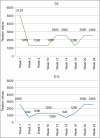Seroconversion, genotyping, and potential mosquito vector identification of Japanese encephalitis virus in pig sentinel settings in Bali, Indonesia
- PMID: 38406355
- PMCID: PMC10884589
- DOI: 10.14202/vetworld.2024.89-98
Seroconversion, genotyping, and potential mosquito vector identification of Japanese encephalitis virus in pig sentinel settings in Bali, Indonesia
Abstract
Background and aims: Despite the endemicity of Japanese encephalitis virus (JEV) in humans and animals in the Province of Bali, Indonesia, there is little data on whether seroconversion to the virus occurs in pigs, JEV genotypes circulating, and it's potential mosquito vectors in the area. The aims of this study were to (i) Determine whether JEV infection in Balinese pigs occurs before reaching their sexual maturity, (ii) identify the genotypes of circulating JEV, and (iii) identify potential JEV mosquito vectors at the study sites in urban and peri-urban areas of Bali.
Materials and methods: Sixteen 1-week-old Landrace piglets from two different sows were housed in Denpasar. Similarly, 18 one-week-old mixed-breed piglets of two different sows were housed in Badung Regency. The piglets were bled every 1 to 4 weeks for up to 24 weeks. Serum samples from the 11 piglets were tested for antibodies against JEV, and seroconversion-suspected sera were titrated using an enzyme-linked immunosorbent assay. Blood of seroconverted sera from pigs were tested using polymerase chain reaction (PCR) to detect the genetic sequence of JEV. The mosquitoes in the sentinels were trapped throughout the study period to identify the potential mosquito vectors of JEV.
Results: Antibodies were detected in most of the selected piglets' sera from weeks 1 to 24 of their age. However, sera of pig B9 collected from the sentinel setting in Badung Regency showed a four-fold increase in antibody titer from week 4 to week 8, indicating seroconversion. PCR testing of blood from B9 (pooled blood sample collected from week 5 to week 8) identified JEV nucleic acids, which were phylogenetically classified as belonging to the JEV genotype III. Meanwhile, 1271 of two genera of mosquitoes, Anopheles spp. and Culex spp. were trapped in the pig sentinels.
Conclusion: JEV seroconversion likely occurs before the pig reaches sexual maturity in Badung Regency. Sequence data indicate that JEV genotype III is circulating in the pig sentinel setting in the regency; however, circulating genotypes need to be clarified through increased surveillance. Meanwhile, Culex spp. and most likely Culex quinquefasciatus and Anopheles spp. were the dominant mosquitoes present in the study sites set in the urban area of Denpasar and peri-urban areas of Badung, Bali, indicating that these are likely vectors in spread of JEV in the region.
Keywords: Japanese encephalitis virus; genotyping; pig sentinel setting; potential mosquito vectors; seroconversion.
Copyright: © Kardena, et al.
Conflict of interest statement
The authors declare that they have no competing interests.
Figures





Similar articles
-
First survey on seroprevalence of Japanese encephalitis in long-tailed macaques (Macaca fascicularis) in Bali, Indonesia.Vet World. 2022 May;15(5):1341-1346. doi: 10.14202/vetworld.2022.1341-1346. Epub 2022 May 27. Vet World. 2022. PMID: 35765485 Free PMC article.
-
Identification and Isolation of Japanese Encephalitis Virus Genotype IV from Culex vishnui Collected in Bali, Indonesia in 2019.Am J Trop Med Hyg. 2021 Jul 19;105(3):813-817. doi: 10.4269/ajtmh.20-1554. Am J Trop Med Hyg. 2021. PMID: 34280147 Free PMC article.
-
Operational trials of remote mosquito trap systems for Japanese encephalitis virus surveillance in the Torres Strait, Australia.Vector Borne Zoonotic Dis. 2007 Winter;7(4):497-506. doi: 10.1089/vbz.2006.0643. Vector Borne Zoonotic Dis. 2007. PMID: 18021024
-
The Emergence of Japanese Encephalitis Virus in Australia in 2022: Existing Knowledge of Mosquito Vectors.Viruses. 2022 Jun 2;14(6):1208. doi: 10.3390/v14061208. Viruses. 2022. PMID: 35746679 Free PMC article. Review.
-
Japanese Encephalitis Virus: The Emergence of Genotype IV in Australia and Its Potential Endemicity.Viruses. 2022 Nov 9;14(11):2480. doi: 10.3390/v14112480. Viruses. 2022. PMID: 36366578 Free PMC article. Review.
Cited by
-
Managing Japanese Encephalitis Virus as a Veterinary Infectious Disease Through Animal Surveillance and One Health Control Strategies.Life (Basel). 2025 Aug 7;15(8):1260. doi: 10.3390/life15081260. Life (Basel). 2025. PMID: 40868908 Free PMC article. Review.
-
Seroprevalence of swine hepatitis E virus and the farmers' potential risk of infection in the Province of Bali, Indonesia.Vet World. 2024 Aug;17(8):1810-1820. doi: 10.14202/vetworld.2024.1810-1820. Epub 2024 Aug 20. Vet World. 2024. PMID: 39328451 Free PMC article.
-
Unique humoral immune response of pigs to repeated natural Japanese encephalitis virus infections: an amplifying host perspective.Arch Virol. 2025 Jan 6;170(2):30. doi: 10.1007/s00705-024-06208-y. Arch Virol. 2025. PMID: 39762620
References
-
- Di Francesco J, Choeung R, Peng B, Pring L, Pang S, Duboz R, Ong S, Sorn S, Tarantola A, Fontenille D, Duong V, Dussart P, Chevalier V, Cappelle J. Comparison of the dynamics of Japanese encephalitis virus circulation in sentinel pigs between a rural and a Peri-Urban setting in Cambodia. PLoS Negl. Trop. Dis. 2018;12(8):e0006644. - PMC - PubMed
-
- Pham-Thanh L, Nguyen-Tien T, Magnusson U, Bui V.N, Bui A.N, Lundkvist A, Vu D.T, Tran S.H, Can M.X, Nguyen-Viet H, Lindahl J.F. Zoonotic Flavivirus exposure in Peri-Urban and Suburban Pig-Keeping in Hanoi, Vietnam, and the knowledge and preventive practice of pig farmers. Trop. Med. Infect. Dis. 2022;7(5):79. - PMC - PubMed
-
- Rattanavong S, Dubot-Peres A, Mayxay M, Vongsouvath M, Lee S.J, Cappelle J, Newton P.N, Parker D.M. Spatial epidemiology of Japanese encephalitis virus and other infections of the central nervous system infections in Lao PDR (2003–2011):A retrospective analysis. PLoS Negl. Trop. Dis. 2020;14(5):e0008333. - PMC - PubMed
-
- Paulraj P.S, Rajamannar V, Renu G, Kumar A. Changing Paradigm in the epidemiology of Japanese encephalitis in India. J. Vector Borne Dis. 2022;59(4):312–319. - PubMed
LinkOut - more resources
Full Text Sources
Miscellaneous
